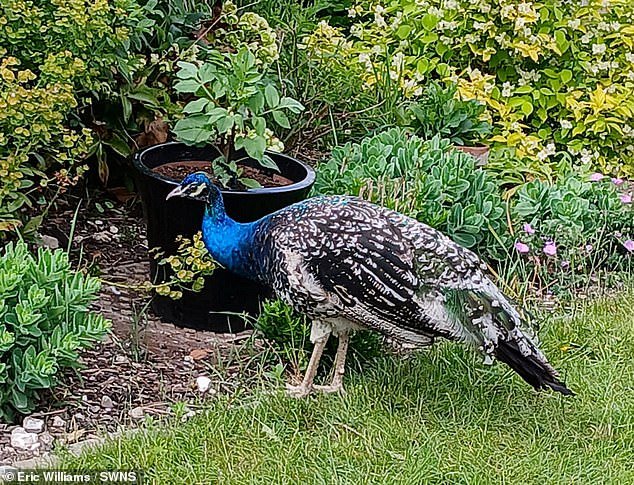A peaceful market town is being terrorised by an antisocial thug tearing apart vegetable patches and waking up the neighbourhood at the crack of dawn with ear-splitting noise.
The perpetrator, a peacock handed the name of Percy by the locals it targets, first makes itself known at 4.30am each day with a mating call heard for miles.
The lovesick bird then moves on to devouring meticulously planted lettuces and courgettes, occasionally tucking into some runner beans on the side.
Hazel Harvey, 67, has been particularly exposed to Percy’s prattling, with her roof in Marlborough, Wiltshire one of the peacock’s favoured vantage points.
The retired accountant said: ‘It walks along our roof and starts calling at around half past five in the morning, which is not the sort of time that I really want to be woken up at.
‘I have been told it is an adolescent male and that the sound is a mating call. But the mating season ended at the end of June.
‘It doesn’t have a hope in hell of finding a mate – its tail feathers are very tatty.’
Peter and Carolyn Nicholls, 78 and 75, recalled finding Percy making himself comfortable in their garden when they got back from holiday.

A peaceful market town is being terrorised by an antisocial thug tearing apart vegetable patches and waking up the neighbourhood – his name is Percy the peacock (pictured)

The bird, pictured on a local’s roof, first makes itself known at 4.30am each day with a mating call heard for miles
Carolyn, a retired nurse, said: ‘It acted like it owned the place. I found little peck marks on our courgettes.
‘We sort of shooed it away but then it just went up on the roof.’
Mr Nicholls added: ‘It must have come from somewhere. Either somebody kept it as a pet or there must be some sort of specialist living nearby.’
Eric Gilbert, 83, a retired headteacher born and raised in the area, said he had seen the peacock eating his beloved hand-grown vegetables.
‘I saw it biting into my runner beans. I was at my bedroom window and saw it standing in the middle of my lettuce patch. It had decided to have a different menu for breakfast I think.’
He added: ‘Another time, it buried itself in my lettuce patch, working itself down into the soil, presumably to look after its feathers or to keep itself cool.
‘When I went up to it, it fluffed up its feathers and ran in circles – going a bit berserk.’
Brendan Palmer, 54, a teacher from Somerset, said he had grown fond of the bird, particularly his ‘cheeky’ personality.

The lovesick bird then descends from the rooftops and moves on to devouring meticulously planted lettuces and courgettes, occasionally tucking into some runner beans on the side

Hazel Harvey, pictured, has been particularly exposed to Percy’s prattling, with her roof in Marlborough, Wiltshire one of the peacock’s favoured vantage points
‘His early routine suits me just fine,’ he admitted. ‘I get up early to do weights in the morning at around 4.30am.
‘He’s my workout alarm. If I hear him crow before I get started, I know I’m running late.
‘Percy is a bird with a serious sense of routine. He comes out of that big tree and goes on to next door’s roof to crow at 4.30am and 9.30pm. Always exactly the same.
‘The only thing is he winds up our dogs, Maggie and Luna when he goes on our back lawn and our front lawn. My dog Luna wants to eat him.’
Alfie Game, 71, a retired botanist, has also had Percy perching on his roof and described how the peacock almost got stuck on his solar panels when reciting his signature mating call.
‘I don’t want him up there because he rolls around trying to wrestle his way out,’ he said.
‘If you chase him around he just looks at you with this astonished expression. I once shooed him away from my garden and he went back up like a balloon onto my roof.
‘He screams for about 20 minutes in the hope that a lady peacock will hear him.

Brendan Palmer, pictured, a teacher from Somerset, said he had grown fond of the bird, particularly his ‘cheeky’ personality

His dog Luna is far from a fan of the feathered fiend and ‘wants to eat him’
‘But you would have thought that by now he would have realised that there aren’t any other peacocks in Marlborough.’
Peacocks were first introduced to the UK in the 14th century when aristocrat Sir John de Foxley brought a couple back from the Holy Land, according to Peacocks UK.
Native to India and Sri Lanka, they have long been kept as status symbols in Britain with many arriving as gifts from foreign rulers.
They became more widely available by the 1600s after a spell of being bred in captivity and remain popular today.

























